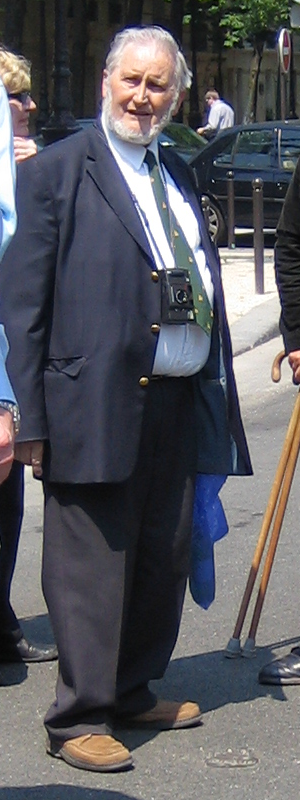
Gilbert Satterthwaite, the Society’s first President, died at his home in Hayes on 20th July 2013. Gilbert was also Chairman of the Society for the History of Astronomy, and well known for his work at Greenwich with Airy’s Transit Circle.
Gilbert became interested in astronomy at the age of 11 and during his last years at school he attended an astronomy class at the college of higher education. He visited the Great Exhibition in London in 1951, especially the Dome of Discovery to see for himself the latest in giant telescopes.
Unimpressed by his school’s career adviser about a career in astronomy, he bought the book “Worlds without End” by Sir Harold Spencer Jones the Astronomer Royal, and sent the book off to the Royal Observatory asking the author to sign it. He did and in doing so encouraged Gilbert to enquire about the possibility of a job. He was given an interview, during which questions became progressively harder and harder. But finally he was offered a job!
Gilbert joined the Meridian Department where he was trained to use the Airy Transit Circle. From his own measurements using this instrument he could check Greenwich Mean Time very precisely.
By chance the last day of official observations at Greenwich had been earmarked as the 31 March 1954 by the Chief Assistant, but it was cloudy. So the last actual measurements were by Gilbert the day before!
Gilbert moved to Herstmonceux in 1954 where he often used its comprehensive library. On one occasion the Astronomer Royal, Sir Richard Woolley entered and to Gilbert’s surprise, addressed him by name.
In 1970 he wrote the “Encyclopaedia of Astronomy”, keeping meticulous notes on a cardex system. No doubt encouraged by this success he edited the “Norton’s Star Atlas” in 1978.
Gilbert’s passion for astronomy was ever present. He taught some very successful astronomy evening classes in Bromley in the 70s and early 80s, and the Orpington Astronomical Society was founded in October 1980 on the back these. Interestingly, the classes also attracted the attention of Charles Chilton of “Journey into Space” fame.
In his later years, he worked as a lab technician in the Applied Optics Laboratory at Imperial College of Science in London. There he looked into the history of the telescope with Colin Ronan. They suggested that the first telescope was in fact made by Thomas Digges some 50 years before Galileo made his. They built a working model of Digges catadioptric telescope which they showed to the Society at a talk in March 1993, which Gilbert updated and reprised in July 2002. The BBC included the telescope, with Gilbert explaining the rather peculiar optics, in an episode of its “What the Tudors Did For Us” TV series first broadcast in September 2002.
Gilbert’s life-long passion, and a subject on which he gave the Society more than one talk, was the life of George Airy – the seventh Astronomer Royal.
Gilbert’s astronomy contacts were instrumental in arranging the Society’s tour of the USA in 1982, and the Society’s visit to the Paris Observatory in 2007. He also helped arrange speakers for a good many of the Society’s regular monthly meetings.
In recent years he gave the Society talks about his experiences while working at Greenwich and Herstmonceux, including some fascinating stories about the Observatory’s move from one site to the other, and the characters involved.

